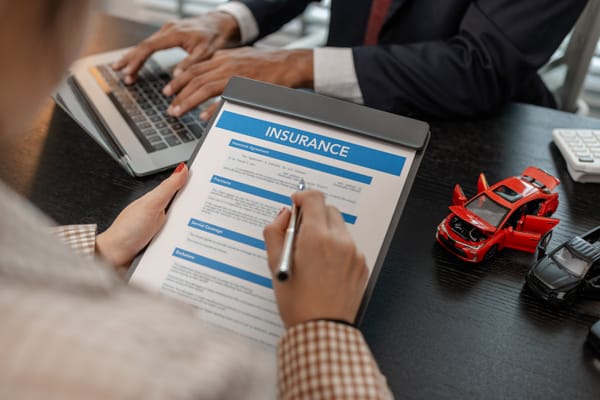Decoding Car Insurance Terms: What They Mean & Why They Matter

You've just bought your dream car. That Nissan saloon is gleaming, the papers are sorted, and you're ready to hit the road. Then someone asks, "Do you have comprehensive or just TPO?"
You freeze. Your brain goes blank.
Here's the truth: most Kenyan drivers don't fully understand their car insurance. They renew it because it's mandatory, not because they know what they're covered for. And when an accident happens? That's when the confusion becomes very expensive.
Here’s a quick guide by Peach Cars that breaks down the key car insurance terms you need to know. It’s got all you need about what matters when you're insuring your ride in Kenya.
Why Understanding Insurance Terms Actually Matters
Third-party car insurance is mandatory by law in Kenya. But beyond avoiding police hassles, understanding your policy means knowing exactly what you're paying for and what protection you actually have.
The difference between comprehensive and third-party coverage can mean thousands of shillings out of pocket after an accident.
Terms like "excess" and "premium" directly affect how much you pay and how much you get back when things go wrong.
Car insurance isn't sexy, but understanding it properly is the difference between driving with confidence and driving with expensive surprises.
Types of Car Insurance in Kenya
In Kenya, motor insurance is generally classified into three types, each offering a different level of financial protection. Knowing the differences is the first step to making a smart decision.
1. Third-Party Only (TPO)
This is the most basic cover and the mandatory legal requirement. Think of TPO as the "I care about other people's problems, not my own" insurance.
Covers:
- Injuries or death you cause to others
- Damage to other people's property
- Legal costs if someone sues you
Doesn't Cover:
- Any damage to your own car
- Theft of your vehicle
- Fire damage to your car
- Your own medical bills
TPO insurance starts from Ksh 5,000 to about Ksh 15,000 annually for most private vehicles. Perfect if you own an older car worth between Ksh 300,000 to Ksh 900,00 or can afford out-of-pocket repairs.
The risk? If someone hits and runs, you foot your own repair bill.
2. Third-Party Fire and Theft (TPFT)
The middle child of car insurance. TPFT covers third-party liabilities plus compensation if your vehicle is stolen or damaged by fire.
TPFT is not very common in Kenya because the cost isn't commensurate with its benefits. You're paying more than TPO but still not covered for accident damage—the most common claim type on Kenyan roads.
Nevertheless, it’s been gaining traction in high-theft urban areas where fire and theft risks are real.
3. Comprehensive Insurance
The full package. Comprehensive offers protection to both parties in case of an accident, plus coverage for your own vehicle's damage regardless of who caused it.
Comprehensive typically covers:
- Accidental damage to your car (even if you're at fault)
- Theft of the entire vehicle
- Fire damage
- Malicious damage and vandalism
- Natural disasters like floods and hailstorms
- Third-party liabilities
Premiums usually start from as low as 2.5% and sometimes go up to over 5%, depending on your vehicle’s model and condition. For a car worth Ksh 1.5 million, this could start from Ksh 37,500 annually.
Worth noting is that insurers generally cover comprehensive risks for vehicles that are 15 years old and below.
Key Insurance Terms Decoded
When you make a claim, these terms decide how much money you actually get.
1. Premium
Your premium is the amount you pay for insurance cover. Usually calculated annually, though many insurers now offer monthly or quarterly plans.
What affects your premium:
- Car value — More expensive cars cost more to insure
- Vehicle age — Cars over 15 years may be declined for comprehensive cover
- Driving record — Clean record means lower premiums
- Location — Higher accident/theft areas mean higher premiums
- Add-ons — Extra benefits increase your premium
Pro tip: Premium percentage rates are negotiable. Shop around before accepting the first quote.
2. Excess (The Self-Pay Option)
This is where many Kenyans get shocked during claims. Excess is the amount your insurer will ask you to pay if you make a claim. It's your share of the repair cost.
Common excess amounts:
- Own damage: Usually 2.5% of vehicle value with a minimum of Ksh 15,000 to Ksh 20,000
- Theft claims: Often 5-25% of the vehicle's value depending on security features
- Windscreen damage: Typically Ksh 2,500 to Ksh 5,000
If your vehicle repair cost is Ksh 150,000 and your policy has a standard Ksh 15,000 Excess, you pay the garage Ksh 15,000, and the insurer pays the remaining Ksh 135,000. Excess discourages misuse on small claims that can be handled without involving the insurer.
3. Excess Protector
Insurance for your insurance. An excess protector covers the amount you'd normally pay out of pocket when making a claim.
The excess protector costs between 0.2% to 0.5% of your vehicle's market value, with a minimum of about Ksh 1,500. For a Ksh 1 million car, that's just Ksh 2,000 to Ksh 5,000 extra annually. Make a claim and you pay nothing out of pocket.
Important: Once used, it's considered utilised and finished. You'd need to reinstate it for future claims.
4. Sum Insured
The maximum amount your insurance company will pay if your car is stolen or written off. The basic premium is computed using the car's insured value, called sum insured, the current market value, not what you originally paid.
You bought your car for Ksh 1.8 million three years ago. Today it's worth Ksh 1.3 million. Your sum insured should be Ksh 1.3 million. That's what you'd get if it was stolen tomorrow.
Keep your sum insured realistic. Overinsuring means paying higher premiums for no extra benefit. Underinsuring means you won't get enough to replace your car.
5. No Claims Discount (NCD)
Your reward for being careful. Every year you go without making a claim, you earn a discount on next year's premium. Some insurers offer up to 50% off after several claim-free years.
The catch? Make one claim and you lose your accumulated discount. It resets. This is why some people pay for small repairs out of pocket rather than claim and lose years of discount benefits.
Total Loss
If repair costs exceed 50% of the sum assured, the policy considers the car a total loss. Insurance doesn't repair your car—they compensate you for its total value instead.
Your car is insured for Ksh 900,000. Repairs cost Ksh 550,000. That's over 50%, so the insurer declares it a total loss, pays you Ksh 900,000 (minus excess), and takes ownership of the wreck.
Must-Know Add-Ons
A comprehensive policy is good, but these add-ons are what make it truly practical.
1. Windscreen Cover
Windscreen damage happens often on Kenyan roads—flying stones from lorries, debris from potholes. Most comprehensive policies include a windscreen limit of Ksh 20,000 to Ksh 50,000 per year.
Need more coverage? Extra windscreen cover typically costs 10% of the additional limit purchased.
2. Political Violence and Terrorism (PVT)
Covers damage from riots, strikes, civil commotion, or terrorist attacks. Typically costs 0.25% of vehicle value with a minimum of Ksh 2,000.
Worth it if you regularly drive through or park in areas prone to protests or unrest.
3. Courtesy Car/Loss of Use
Gives you a courtesy car for up to 27 days while your car is being repaired. Only applies after your claim has been lodged and accepted.
Super useful if your car is your daily commute solution. The benefit usually ceases once used, but can be reinstated at an additional cost.
Third-Party Liability Limits
It's vital to know the limits your insurer will pay for damages you cause to others:
- Third-Party Property Damage (TPPD) Limit: The maximum amount paid for damage to another person's property. In Kenya, this limit is often up to Ksh 20 million for comprehensive policies.
- Third-Party Bodily Injury/Death Limit: This covers compensation for injury or death caused to a third party. Most comprehensive policies offer coverage up to Ksh 3 million per person and often a higher total limit per event.
Choosing the Right Cover
Don't just pay; be smart about it.
Go Comprehensive if:
- Your car is worth more than Ksh 500,000
- You have a loan (banks require comprehensive cover)
- You can't afford to replace the car out of pocket
- Your car is 15 years old or newer
Stick with TPO if:
- Your car is old and worth less than Ksh 300,000
- You can afford repairs from your own pocket
- You're on a tight budget
- Your car is over 15 years old
Consider Key Add-Ons:
- Excess protector — For zero out-of-pocket costs during claims
- PVT cover — If you drive through politically volatile areas
- Courtesy car — If your car is your only transport
- Extra windscreen — If your windscreen is expensive to replace
Whatever you choose, read your policy documents. Understand your excess amounts. Know what's covered and what's not. The worst time to discover you don't understand your insurance is when you're standing beside your crashed car.
The Bottom Line
Buy insurance that actually protects you, not just meets the legal minimum. And for the love of good driving, renew on time.
Ready to protect your ride properly? At Peach Cars, we connect you with trusted insurance partners who can set you up with the right cover at competitive rates. Every car we sell can leave the lot fully insured and ready to hit the road.
Browse our inventory today and drive home with confidence. Call us on 0709 726 900 or visit our showrooms in Lavington, Lang’ata Road, and Windsor.
Come and Peach It, and Move with Confidence.




